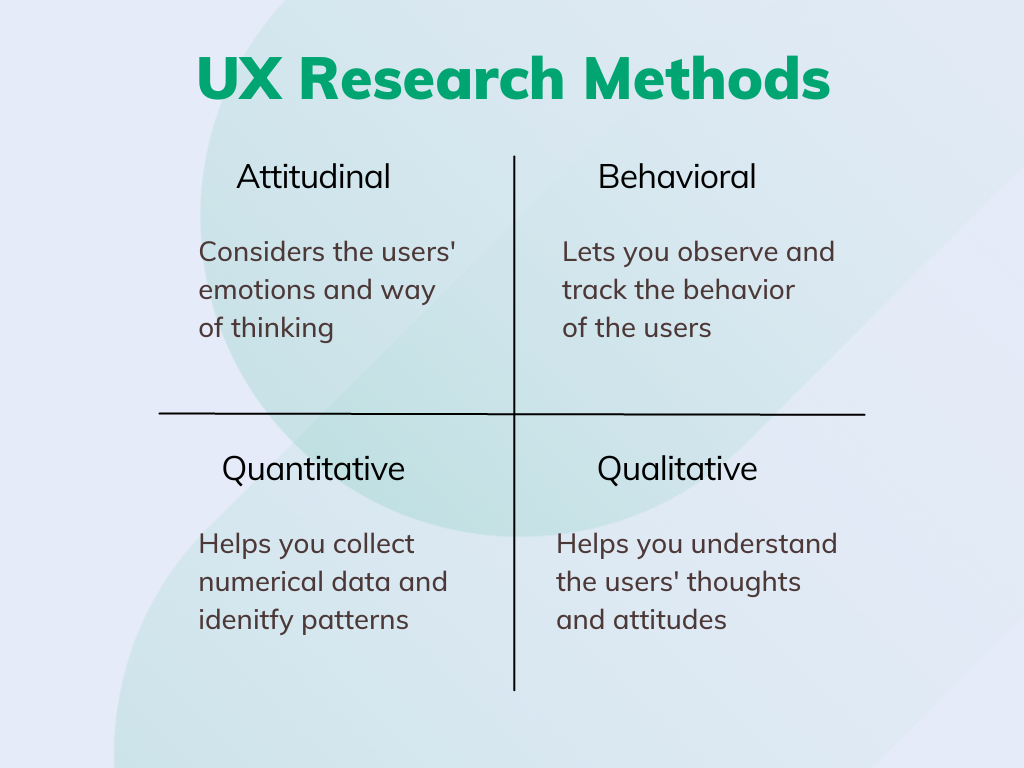How to conduct effective UX research

In today’s competitive field, where there is a wide selection of products on the market, it is crucial to ensure that your own products live up to users’ expectations to increase your chances of success. Doing UX research allows you to comprehend your target audience and their needs fully. By understanding your users and their needs, you can develop a product that addresses those needs and is also something they are willing to pay for. It’s important to remember that the users ultimately decide if the product you delivered brings them any value.
So how can you get to know your users and learn about their problems? Through conducting UX research! Studies show that investing in UX during the discovery phase reduces overall development time by 33-50%. Additionally, according to the same source, it is said that every $1 invested in UX brings $100 in return.
In this article, we will give you a peek into the world of UX so you can better understand the process and gain the necessary knowledge that will prepare you for collaboration with an expert in this field. By teaming up with someone with the skills, knowledge, and experience, you can significantly increase your chances of building a product that users will love and keep using.
What is UX research, and why is it important?
User experience research is a process in which you discover and get to understand the users’ needs, motivations and behaviors.
The benefit of this is that you won’t create products that nobody wants. You don’t waste your precious time on developing solutions that aren’t validated or your resources on fixing mistakes that could have been avoided. Conducting user experience research helps to remove unfounded assumptions from your product design process.
It is vital to understand that this process is a systematic study. This means that initially, you start with generative research, which allows you to gain a deeper understanding of the problem that you want to address.
During the problem discovery phase, your goal should be to gather the necessary information about your users and learn as much as possible about their problems and needs. As you learn more about your audience and bring in new insights, you fill the gaps in your knowledge. Knowing your users will lead you to make smart decisions about what should be done to solve their problems.
The data collected from UX research will guide your thought process when you’re at the point of brainstorming for potential solutions. After all, what can be the best inspiration for your solution if not the users? As previously mentioned, UX research is an ongoing process and should be a consistent part of not only the discovery phase but also after launching your product. Oftentimes, you will have to check if your hypotheses are correct and verify your assumptions. By regularly checking up with your users, you will be able to tell if you’re heading in the right direction with your idea.
Who is involved in the UX research process?
Founder
As the founder of your business, you can expect a lot of questions to come your way from the UX researcher. You can also use this opportunity to ask questions from your side to understand the process of UX research better. Thanks to this approach, you can be sure that you’re on the same page and avoid any misunderstandings.
Stakeholder engagement is vital to the success of UX research, and as a founder, you serve as a key stakeholder. Your involvement ensures the research aligns with business goals, while fostering open communication between all parties.
What are some of the questions that you can prepare for? Here are some examples of the questions a UX researcher may ask!:
– Are there currently any hypotheses about your product?
– What assumptions need to be checked?
– What questions about your product/market are you trying to answer?
– What is already known to us?
– Have any user profiles been created?
– How does the research fit into the goals of the entire organization?
– Has UX research previously been conducted? If yes, what were the results?
– Is there any documentation that includes useful information for us?
– What are the preferences regarding communication and collaboration?
If this seems overwhelming, don’t worry! Provide as much information as possible and work with your researcher to gather any missing pieces. In the end, it is the UX researcher that ensures everything falls into place. Through collecting, sorting out, and analyzing various data, they can verify whether the chosen target audience is, in fact, the right one. Apart from that, based on the collected information, the UX researcher will be able to determine the goal of the research.
UX researcher
The role of the UX researcher (or the UX research team) is to assemble all of the requirements and go through the data of previously conducted research (given that it was conducted in the past). Based on the findings, the researcher creates a research plan, prepares a screener, and performs the research itself. After that, the UX researcher analyses the data and presents all of the insights to the stakeholders.
The UX researcher focuses on getting to know the user inside out. They learn about their problems, needs, and dislikes. But also about what works for them and what brings them joy. The knowledge of those things will be fundamentally useful during the discovery phase. As you move forward with your project, the research and hypotheses will change. Depending on the phase that you are in, the UX researcher will pick out different methods that will be applicable to your case. By considering the users, they can gather the necessary data and translate it into information that is valuable for your business, no matter the stage you’re in.
Product Owner
At the beginning of the research, the Product Owner should provide the UX researcher with all of the available information and fill in any knowledge gaps.
It is also beneficial for Product Owners to sit in during the research sessions and observe how the research is conducted. This can benefit them as they can gain valuable insights based on rich first-hand data. They can also provide useful feedback, which can help in changing the direction of the research if necessary.
Product owners are responsible for tracking the analytics to know if the product goal has been achieved. This is why it’s good to agree on a shared vision as well as the objectives and metrics of success connected to both UX and the business side.
How to conduct UX research
STEP 1. Set research goals for your research plan
Although you may think that you know your target users well enough, it’s best to leave the research plan development in the hands of the UX researcher. In many cases, we might be surprised by how different our target audience is from what we initially pictured it to be. What you can do to accommodate this process is share any potentially helpful information that you might have, as well as the business goals you want to achieve with your product. As the UX researcher establishes the goals and direction of the research, you can think about how you will later implement the findings that result from it. After receiving information about your target audience, you will have to act on those insights and make some decisions. The UX researcher is there to nudge you in the right direction and improve the quality of your choices by giving you the needed knowledge about your users.
The research goals will change depending on the stage you’re at with your idea (and, later, with your product). Here are a few examples of the goals you might come across in the research plan:
– To find out the user’s pain points and the problems that they are facing
– To verify if you’ve chosen the correct target audience
– To understand the habits and behaviors of your potential users
– To see how your users navigate across your product (once it has been developed)
STEP 2. Choose your research methods
Once the goals have been decided, the next thing that needs to be done is selecting the appropriate UX research methods. The techniques the UX researcher will use depend on the amount of time you have, your budget, and the questions that need to be answered. Using multiple research methods will be most beneficial as it can provide you with data from different angles and fill in any knowledge gaps.
Before we discuss the most common research methods, we will address the 3 research dimensions that the methods are mapped across.
Attitudinal & behavioral research
This refers to the distinction between what people say and what they actually do, which often is very different. Attitudinal research is used to collect information about the preferences of our users (their self-reported statements about their thoughts). Surveys, interviews, and focus groups are some examples of the methods used in this type of research. On the other hand, behavioral research lets you observe and track the behavior of the users. Eye tracking and ethnographic research are excellent examples of sources that provide you with such information.
Quantitative & qualitative research
In a nutshell, the difference between quantitative and qualitative research methods is that quantitative research results in receiving numerical data, and qualitative user research gives you a sense of what motivates your users. Quantitative research allows you to accumulate large amounts of statistical data; however, conclusions drawn from the results may be completely different than what can be deduced from qualitative research. Which is why analyzing the results can be pretty tricky.
Quantitative research uses methods such as surveys, heatmaps, recordings, a/b testing, and eye tracking. Methods like these allow you to identify patterns in things like conversions or click-through rates and make predictions based on this data.
Qualitative methods focus on understanding your users’ thoughts and attitudes and can be obtained through techniques like IDIs (In-Depth Interviews) or FGDs (Focus Group Discussions).
Context of use
Context of use allows you to focus on when, why, and how the users are performing a task or using a product. It describes the environment, conditions, and constraints associated with the use of a specific product or service in an average day situation. A good way to collect this information is through usability tests.

Common UX research methods
User interviews
User interviews allow you to discover the needed information through conversations with the users. The process involves asking a single user multiple questions regarding a topic of interest while noting or recording the answers. It allows you to discover the habits and user behaviors, the challenges they encounter, or how they use a particular product.
User interviews are usually one-on-one sessions and take from around 30 minutes to an hour. In order to get the most out of this technique, it is vital to ask the right questions. Avoid terms that the participant might not be familiar with (professional words such as “user flow” might sound confusing) and encourage them to speak freely and feel comfortable. When selecting questions, bear in mind that closed-ended questions won’t provide you with many insights, so it’s best to go for open-ended ones.
Ethnography research
Ethnography research, also known as field research, focuses on studying how people interact and behave in their natural environment. In this process, the researcher can observe participants in their natural settings, such as their homes, workspace, cafe, etc., to gain a more contextual understanding of their needs.
Thanks to these observations, you can see how existing solutions work in everyday situations and why users behave the way they do. It helps researchers understand the gaps between what users say they do and what they actually do.
Usability testing
Usability testing is a method that allows you to evaluate your product by observing how potential users interact with it. During the test, participants are asked to complete a set of tasks while the UX researcher observes their reactions and takes notes. The main purpose of usability testing is to identify usability problems and determine if the product (or the part of it) that is being tested is intuitive and understandable enough for the users. Through these tests, the researcher is able to check the effectiveness of your potential solution and how your users engage with it (this part will be covered in the Solution Definition chapter). When it comes to the types of tests, we can distinguish between two, which are:
- Moderated tests – a moderator has to be present to get the user back on track if they misunderstood something during the session.
- Unmoderated tests – in this case, the participants have to do everything independently and don’t receive any clarification when answering questions or solving tasks.
An example of a tool you can use for this method is Usertesting.com which allows you to perform both unmoderated and moderated usability tests.
Surveys
Surveys allow you to accumulate a large amount of data about a particular group in a short amount of time. Using them will enable you to gain insights into market trends and customer satisfaction. One of the downsides of this research method is that it doesn’t allow you to have direct contact with the participant to explain any misconceptions they might have. A good survey includes feedback questions as well as follow-up and open-ended ones. Avoid using leading questions that prompt the user to respond in a biased way. You can create a survey that can be emailed to your target group by using tools like Google Forms.
A useful tool that can help you gather the right participants for the next types of research is a screener survey. This survey comprises a few questions that give you more information regarding the respondent’s characteristics. Simply put, a screener survey lets you “capture” your intended audience, so you can collect user feedback that is relevant to your needs.
Card sorting
In this UX research method, users sort and group cards in a way that makes the most sense to them. This method allows researchers to assess the information architecture and ensure that the structure is suited to the users’ preferences. You can use physical post-it notes to do this or online digital tools such as Miro. Closed card sorts provide the user with a set of terms and the names of the categories they should be divided between. In the case of open card sorts, users have to come up with the names of the categories based on what they think is the most appropriate.
STEP 3. Assemble your findings
After completing your UX research, it’s time to get into the nitty-gritty and analyze your results. By the end of conducting UX research, the researcher will have gathered lots of data that should be investigated and turned into valuable insights.
Gathering information is one thing, but decoding it and communicating it effectively is another. Therefore, the next step that should be taken is to analyze data and prioritize the findings. You need to create a list of your target users’ problems, needs, and goals and arrange them in the correct order of priority. This is also the moment where you go back to the very beginning of your journey and decide if the goals you set in the research plan have been achieved. Did you get the answers to your questions? Make sure that the UX research findings are accessible to your team, and keep everyone informed of the process.
Apart from UX analysis reports, data can be structured using affinity diagrams as well as used to create user personas and user stories.
Affinity diagrams
Quantitative data can be expressed in the form of numbers and statistics. But, when it comes to qualitative data, it can be challenging to translate it into an actionable plan. This is where you can use an affinity diagram, which is a tool used for organizing data and ideas into groups of similar items.
Affinity diagrams allow you to map out the patterns that have surfaced from the research results. This tool uses thematic analysis to make sense of observations and discoveries by sorting them according to different themes.
The themes you can use to digest your UX research data are, for example:
- Frequently used words or terms
- Reactions or frustrations regarding various aspects of your product
- Ideas for improvement
You can create an affinity diagram by gathering all of your key findings and checking if there are any patterns. Then, group all of your notes by those patterns or themes and name each of those groups appropriately.
User personas
User personas are the representation of the group that captures the patterns in their behaviors and approaches. They are created based on the qualitative insights of your UX research. Apart from the observed behavior patterns of your potential user, it also includes information related to their needs and goals. Creating personas allows you to design your solution in a user-centric approach, making it more likely for your product to resonate with your prospects.
User stories
A user story is a short, goal-oriented statement written from the user’s perspective. The format of such a sentence is as follows:
“As a [user], I want [action] so that [purpose].”
These short statements frame your users’ problems and will help decide how you will address those issues. Creating user stories is essential during the discovery phase of a project, as it will point you in the right direction when you begin the development process. That being said, user stories should be created regularly throughout the development and even after the product launch.
Conclusion
UX research will help you create a product that serves your business needs and is optimal for your target audience. By understanding your users’ needs and pain points, you will be able to design a solution that they will love. And as a result, you will create a loyal customer base that will stick with your product through thick and thin.
It’s not easy to conduct research, but it is definitely worth the hassle as it will set the stage for the product development process. UX research helps fight the urge to design the product for ourselves or the stakeholders and instead shines the spotlight on the user. Comprehensive UX research builds a solid foundation for your product, making it easier to adapt and grow as your business develops. At Pragmatic Coders, we’ve had the privilege of working on many incredible projects with our clients, and we know what it takes to conduct effective UX research that brings the desired results. Boost your chances of success by collaborating with our experienced professionals! For more information, check out our UX Research Services!
Psst… Check out other product-related articles below:
- Are you sure your startup is solving the right problem? Engaging UX and UI designers in the process of building new products
- UI Design: An introduction to user interface design
- UX Explained: What is it? How much does it cost? Do I need it?
- What does a Product Designer do? Product Design vs. UX easily explained
- What is UX writing?
- Top 5 UX myths that are costing your startup money








